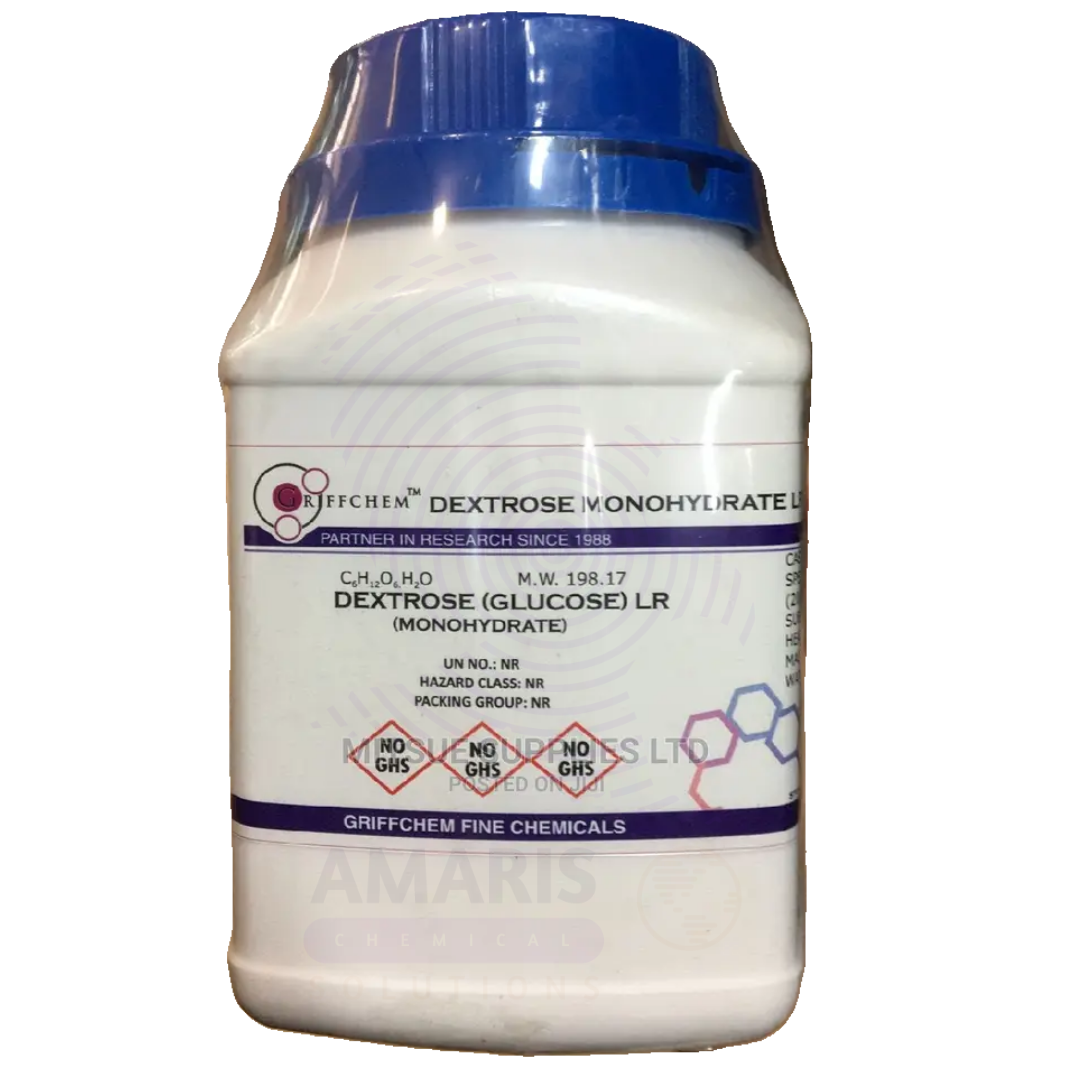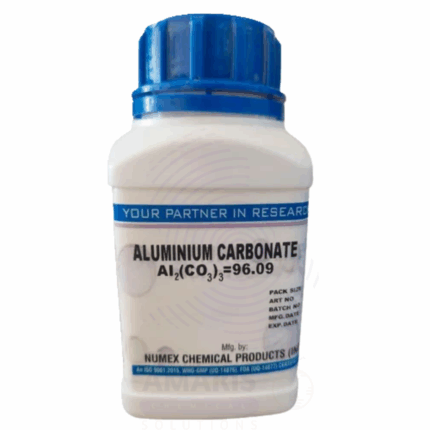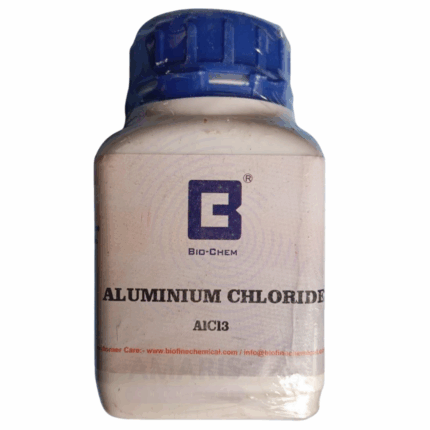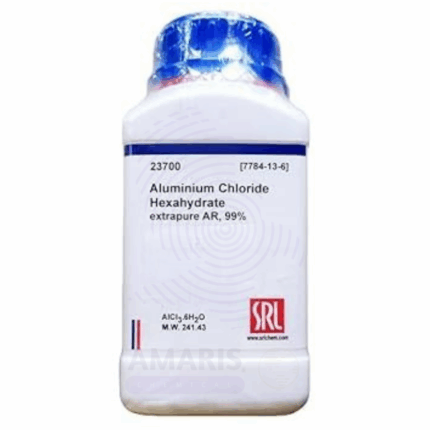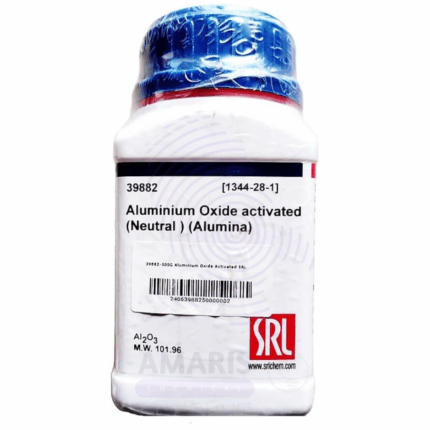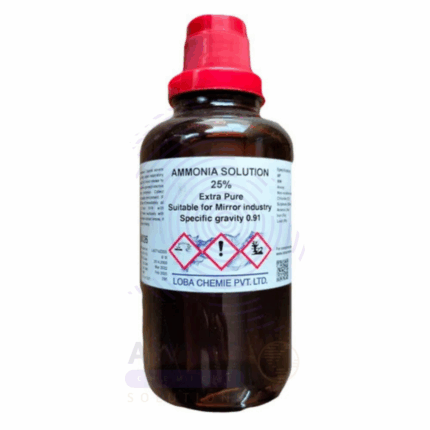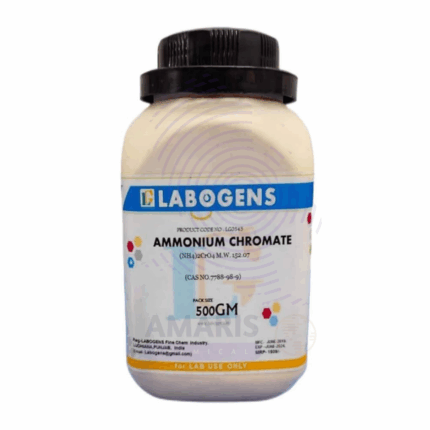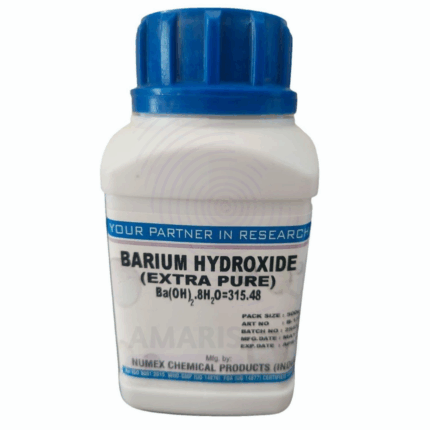“Ammonium Chloride Extra Pure” has been added to your cart. View cart
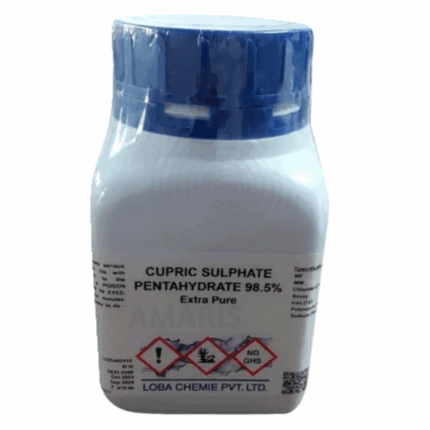
Cupric Sulphate Pentahydrate Extra Pure
$ 19.50 Original price was: $ 19.50.$ 19.32Current price is: $ 19.32.
Dextrose Monohydrate Glucose Extra Pure
$ 18.15
Whatsapp Order
Dextrose Monohydrate Glucose Extra Pure is a laboratory-grade form of glucose with one molecule of water per glucose unit, offering high purity and excellent solubility in water. It serves as a vital energy source in microbiological culture media, fermentation experiments, and biochemical assays. Its predictable behavior and minimal impurities make it suitable for preparing reagents, buffers, and standard solutions in analytical and biological research. This compound is especially useful in cell culture work and metabolic studies where glucose is a key variable. Store in an airtight container away from moisture and direct sunlight to maintain its crystalline integrity.
Description
Table of Contents
Toggle
Dextrose Monohydrate Glucose Extra Pure
Primary Uses
- Carbon Source in Culture Media
- Supplies energy for microbial growth in bacteriological and mycological media.
- Fermentation Studies
- Used as a glucose substrate in yeast/bacteria fermentation experiments.
- Biochemical Assays
- Involved in tests like glucose oxidase assays, DNS, Benedict’s, and Fehling’s for sugar quantification.
- Osmotic Balancing Agent
- Added to buffers and solutions to maintain osmotic pressure in biological systems.
Secondary Uses
- Cryopreservation Component – Stabilizes cells and enzymes during freezing.
- Standard Compound – For calibration of reducing sugar tests and carbohydrate analysis.
- Educational Labs – Used in demonstrating sugar reactivity and Maillard reactions.
Additional information
| PACK SIZE |
500 grams Plastic Tin |
|---|
KEY PRODUCT FEATURES
1. Basic Identification Attributes
- Chemical Name: Dextrose Monohydrate (Glucose)
- Other Names: D-Glucose Monohydrate, Corn Sugar, Grape Sugar
- CAS Number: 14431-43-7
- Chemical Formula: C₆H₁₂O₆·H₂O
- Molar Mass: 198.17 g/mol
- Grade: Extra Pure (Laboratory Grade)
2. Physical & Chemical Properties
- Appearance: White crystalline powder or fine granules
- Odor: Odorless
- Taste: Distinctly sweet
- Solubility: Freely soluble in water, slightly soluble in ethanol
- Melting Point: ~83 °C (with decomposition)
- Optical Rotation: +52.5° to +53.5° (in aqueous solution)
- Hygroscopicity: Hygroscopic — absorbs moisture from the air
3. Safety & Hazard Attributes
- GHS Classification: Not hazardous under normal lab use
- Hazard Statements: None
- Precautionary Measures:
- Avoid generating dust
- Use standard PPE (gloves, goggles, dust mask if airborne)
- First Aid:
- Inhalation: Move to fresh air
- Skin/Eye Contact: Wash with water
- Ingestion: Non-toxic in small quantities
4. Storage & Handling Attributes
- Storage Conditions:
- Keep in tightly sealed container
- Store in a cool, dry place
- Protect from moisture and light
- Handling Advice:
- Avoid dust formation
- Use in a dry atmosphere when weighing
5. Regulatory & Compliance Attributes
- EINECS Number: 200-075-1
- UN Number: Not applicable
- REACH Status: Exempt (naturally occurring sugar)
6. Laboratory Applications
- Primary Uses:
- Nutrient for microbial and cell culture media
- Standard reducing sugar in chemical analysis (e.g., Benedict’s test, Fehling’s test)
SAFETY HANDLING PRECAUTIONS
SAFETY PRECAUTIONS
- PPE Required:
- Gloves
- Lab coat
- Safety goggles (when weighing or mixing)
- Storage Guidelines:
- Store in a cool, dry area
- Use airtight containers to avoid clumping (hygroscopic)
- Keep away from direct sunlight and moisture
- Handling Tips:
- Avoid inhaling dust
- Use a dust mask in bulk handling situations
- Use deionized water when preparing solutions for sensitive assays
FIRST AID MEASURES
- Inhalation: Remove to fresh air; rinse mouth and nose if irritation occurs
- Skin Contact: Wash with soap and water
- Eye Contact: Rinse thoroughly with water for several minutes
- Ingestion (Lab Use): Though low in toxicity, not intended for consumption due to lab-grade purity and potential contamination
FIRE SAFETY MEASURES
- Fire Hazard: Slightly combustible as a fine powder
- Explosion Risk: Dust may form explosive mixtures with air
- Extinguishing Agents: Water spray, foam, dry chemical, or CO₂
- Special Note: Use care to avoid creating dust clouds near open flames
Related products
Aluminium Carbonate Extra Pure
Aluminium Carbonate Extra Pure is a high-purity, white, odorless powder primarily used as a reagent in laboratory settings for analytical and research applications. Though not commonly stable under standard conditions, it is valued in controlled experimental procedures involving the study of aluminum compounds, buffer systems, and inorganic reactions. Its extra pure grade ensures low levels of contaminants, making it suitable for precise qualitative and quantitative analysis. Due to its sensitivity to moisture and tendency to decompose into aluminum hydroxide and carbon dioxide, it must be handled with care and stored in airtight containers under dry conditions to maintain chemical integrity during laboratory use.
Aluminium Chloride Anhydrous Extra Pure
Aluminium Chloride Anhydrous Extra Pure is a high-purity, white to yellowish crystalline compound that is highly hygroscopic and fuming in moist air. It is extensively used in laboratory chemistry as a powerful Lewis acid catalyst, particularly in Friedel-Crafts alkylation and acylation reactions, as well as in the synthesis of organometallic compounds. Its anhydrous form ensures optimal reactivity and effectiveness in moisture-sensitive processes, including polymerization and halogenation studies. Due to its corrosive nature and tendency to react violently with water, it must be handled in a dry, controlled environment using proper safety measures. This extra pure grade is ideal for high-precision analytical and preparative procedures in organic and inorganic chemistry research.
Aluminium Chloride Hydrated Extra Pure
Aluminium Chloride Hydrated Extra Pure is a high-purity, white to pale yellow crystalline compound containing bound water molecules, making it less reactive than its anhydrous counterpart but still highly effective in various laboratory applications. It is commonly used in aqueous-phase reactions, coordination chemistry, and as a reagent for studying aluminum ion behavior in solution. The hydrated form offers enhanced stability and ease of handling, making it suitable for educational experiments, buffer formulations, and inorganic synthesis where precise aluminum content is required. Its extra pure grade ensures minimal interference from impurities, supporting accurate and reproducible results in analytical and research settings. Proper storage in a cool, dry place is essential to prevent further hydration or contamination.
Aluminium Oxide Active Neutral Extra Pure
Aluminium Oxide Active Neutral Extra Pure is a high-purity, fine white powder known for its high surface area and neutral pH, making it ideal for chromatography, adsorption, and catalyst support in laboratory research. Its active form ensures excellent capacity for separating and purifying organic compounds without altering their chemical structure, especially in column chromatography applications. Commonly used in analytical, organic synthesis, and material science laboratories, it provides consistent performance in adsorption studies, drying of solvents, and reaction monitoring. The extra pure grade ensures extremely low levels of impurities, suitable for high-precision experimental work. To maintain its activity, it should be stored in airtight containers away from moisture and reactive chemicals.
Ammonia Solution Extra Pure
Ammonia Solution Extra Pure is a high-purity, clear, colorless liquid composed of ammonia gas dissolved in water, emitting a strong, characteristic pungent odor. Widely used in laboratory chemistry, it serves as a crucial reagent in acid-base titrations, complexometric analysis, and the preparation of ammonium salts and metal-ammonia complexes. Its alkaline nature makes it valuable for pH adjustment, cleaning of laboratory glassware, and as a reducing agent in certain analytical procedures. The extra pure grade ensures low levels of impurities, supporting reliable results in sensitive experimental work. Due to its volatility and corrosiveness, it should be handled in well-ventilated areas and stored in tightly sealed, chemically resistant containers.
Ammonium Chromate Extra Pure
Ammonium Chromate Extra Pure is a high-purity, yellow crystalline compound primarily used in laboratory settings for analytical and inorganic chemistry applications. It serves as a strong oxidizing agent and is commonly utilized in qualitative analysis, particularly in the detection of cations, and in the preparation of chromate-based reagents. Its high solubility in water and ability to act as a corrosion inhibitor also make it useful in material science and electrochemical experiments. Due to the presence of hexavalent chromium, it is toxic and environmentally hazardous, requiring strict handling procedures and protective equipment. The extra pure grade ensures minimal impurities, making it suitable for high-precision research. It must be stored in tightly sealed containers, away from light, heat, and incompatible substances.
Barium Hydroxide Hydrate Extra Pure
Barium Hydroxide Hydrate Extra Pure is a high-purity, white crystalline compound containing eight molecules of water of crystallization. It is widely used in laboratory chemistry as a strong base in titration, qualitative analysis, and inorganic synthesis. Its high solubility in water and strong alkalinity make it valuable for neutralization reactions, preparation of barium salts, and as a reagent for detecting sulfates, carbonates, and phosphates. In analytical applications, it is often used where precise pH control and minimal contamination are critical. The extra pure grade ensures consistent performance in high-accuracy experiments. It should be handled with care and stored in a tightly sealed container in a cool, dry place, as it is caustic and sensitive to carbon dioxide in the air, which can lead to carbonate formation.


 Preservatives(food)
Preservatives(food) Flavor Enhancers
Flavor Enhancers Acidulants
Acidulants Sweeteners
Sweeteners Antioxidants
Antioxidants Colorants(food)
Colorants(food) Nutraceutical Ingredients (food)
Nutraceutical Ingredients (food) Nutrient Supplements
Nutrient Supplements Emulsifiers
Emulsifiers
 Collectors
Collectors Dust Suppressants
Dust Suppressants Explosives and Blasting Agents
Explosives and Blasting Agents Flocculants and Coagulants
Flocculants and Coagulants Frothers
Frothers Leaching Agents
Leaching Agents pH Modifiers
pH Modifiers Precious Metal Extraction Agents
Precious Metal Extraction Agents
 Antioxidants(plastic)
Antioxidants(plastic) Colorants (Pigments, Dyes)
Colorants (Pigments, Dyes) Fillers and Reinforcements
Fillers and Reinforcements Flame Retardants
Flame Retardants Monomers
Monomers Plasticizers
Plasticizers Polymerization Initiators
Polymerization Initiators Stabilizers (UV, Heat)
Stabilizers (UV, Heat)
 Antifoaming Agents
Antifoaming Agents Chelating Agents
Chelating Agents Coagulants and Flocculants
Coagulants and Flocculants Corrosion Inhibitors
Corrosion Inhibitors Disinfectants and Biocides
Disinfectants and Biocides Oxidizing Agents
Oxidizing Agents pH Adjusters
pH Adjusters Scale Inhibitors( water)
Scale Inhibitors( water)
 Antioxidants(cosmetic)
Antioxidants(cosmetic) Emollients
Emollients Fragrances and Essential Oils
Fragrances and Essential Oils Humectants
Humectants Preservatives
Preservatives Surfactants(cosmetic)
Surfactants(cosmetic) Thickeners
Thickeners UV Filters
UV Filters
 Fertilizers
Fertilizers Soil Conditioners
Soil Conditioners Plant Growth Regulators
Plant Growth Regulators Animal Feed Additives
Animal Feed Additives Biostimulants
Biostimulants Pesticides (Herbicides, Insecticides, Fungicides)
Pesticides (Herbicides, Insecticides, Fungicides)
 Active Pharmaceutical Ingredients (APIs)
Active Pharmaceutical Ingredients (APIs) Excipients
Excipients Solvents(pharmaceutical)
Solvents(pharmaceutical) Antibiotics
Antibiotics Antiseptics and Disinfectants
Antiseptics and Disinfectants Vaccine Adjuvants
Vaccine Adjuvants Nutraceutical Ingredients (pharmaceutical)
Nutraceutical Ingredients (pharmaceutical) Analgesics & Antipyretics
Analgesics & Antipyretics
 Analytical Reagents
Analytical Reagents Solvents(lab)
Solvents(lab) Chromatography Chemicals
Chromatography Chemicals Spectroscopy Reagents
Spectroscopy Reagents microbiology-and-cell-culture-reagents
microbiology-and-cell-culture-reagents Molecular Biology Reagents
Molecular Biology Reagents Biochemical Reagents
Biochemical Reagents Inorganic and Organic Standards
Inorganic and Organic Standards Laboratory Safety Chemicals
Laboratory Safety Chemicals Specialty Laboratory Chemicals(Special Laboratory Equipment)
Specialty Laboratory Chemicals(Special Laboratory Equipment)
 Demulsifiers
Demulsifiers Hydraulic Fracturing Fluids
Hydraulic Fracturing Fluids Scale Inhibitors(oil)
Scale Inhibitors(oil) Surfactants(oil)
Surfactants(oil) Drilling Fluids
Drilling Fluids
 Dyes and Pigments
Dyes and Pigments Bleaching Agents
Bleaching Agents Softening Agents
Softening Agents Finishing Agents
Finishing Agents Antistatic Agents
Antistatic Agents
 Admixtures
Admixtures Waterproofing Agents
Waterproofing Agents Sealants and Adhesives
Sealants and Adhesives Curing Compounds
Curing Compounds Concrete Repair Chemicals
Concrete Repair Chemicals Anti-Corrosion Coatings
Anti-Corrosion Coatings
 Surfactants(cleaning)
Surfactants(cleaning) Builders
Builders Enzymes
Enzymes Solvents (Cleaning)
Solvents (Cleaning) Fragrances
Fragrances
 Electronic Chemicals
Electronic Chemicals Catalysts
Catalysts Lubricants
Lubricants Photographic Chemicals
Photographic Chemicals Refrigerants
Refrigerants Automotive chemicals
Automotive chemicals Pyrotechnic Chemicals
Pyrotechnic Chemicals
 Biodegradable Surfactants
Biodegradable Surfactants Bio-based Solvents
Bio-based Solvents Renewable Polymers
Renewable Polymers Carbon Capture Chemicals
Carbon Capture Chemicals Wastewater Treatment Chemicals
Wastewater Treatment Chemicals
 Pigments
Pigments Solvents(paint)
Solvents(paint) Specialty Coatings
Specialty Coatings Binders/Resins
Binders/Resins Additives
Additives Driers
Driers Anti-Corrosion Agents
Anti-Corrosion Agents Functional Coatings
Functional Coatings Application-Specific Coatings
Application-Specific Coatings
 Fresh Herbs
Fresh Herbs Ground Spices
Ground Spices Whole Spices
Whole Spices Spice Blends
Spice Blends Dried Herbs
Dried Herbs
 Leavening Agents
Leavening Agents Dough Conditioners
Dough Conditioners Flour Treatments
Flour Treatments Fat Replacers
Fat Replacers Decoratives
Decoratives Preservatives(baking)
Preservatives(baking)
 Plasticizers & Softeners
Plasticizers & Softeners Reinforcing Agents
Reinforcing Agents Adhesion Promoters
Adhesion Promoters Vulcanizing Agents
Vulcanizing Agents Antidegradants
Antidegradants Blowing Agents
Blowing Agents Fillers & Extenders
Fillers & Extenders Accelerators & Retarders
Accelerators & Retarders